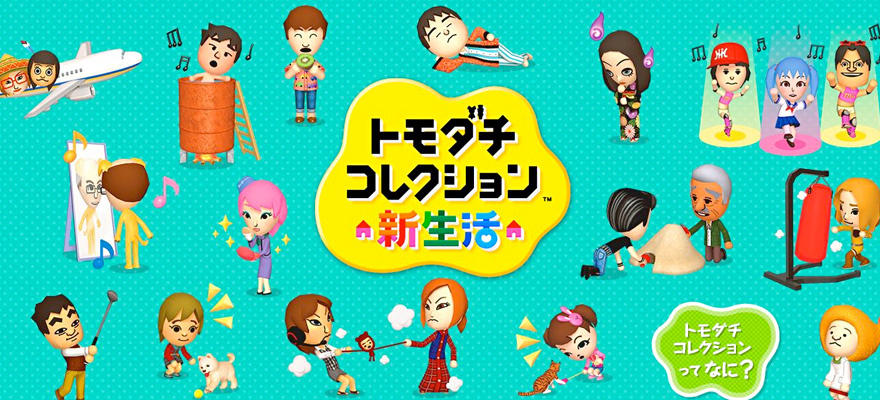
With Tomodachi Life‘s release right around the corner, we thought it would be the perfect time to reflect on the origin of Nintendo’s quirky series. While our time with the Move-In Version of the game provided a nice glimpse of what to expect, there’s an even better source to learn more about Tomodachi Life: straight from the original. Tomodachi Life is actually the second installment in the series. The first game, Tomodachi Collection, sadly never made it outside of Japan. To prep everyone even further for Friday’s launch, let’s take a peek at the original and delve a little deeper into its history!
Tomodachi Collection was released for DS in 2009, with Metroid creator Yoshio Sakamoto as producer. Developed by a more youthful collaborative of Nintendo staffers, Tomodachi Collection was created to be different from anything else on the market. Sakamoto, who had also contributed to titles like Rhythm Heaven and a number of WarioWare installments, said that part of the vision behind Tomodachi Collection was to create a new gaming experience for players. Unlike Animal Crossing, which separates the player into a pocket world away from reality, Tomodachi Collection gleefully immersed them in a facsimile of their own world, instead. Gone were animal neighbors, replaced with Miis pulled straight from players’ friends and families.
“Tomodachi” roughly translates to “friends” in English, making the title, aptly enough, “Friends Collection.” Which was fitting, too, as it succinctly summed up what the game was about and the main thing that made it so addicting. Not simply because seeing digital avatars of loved ones was amusing (though that was certainly part of it), but also due to the extremely goofy antics that the Miis took part in. Japanese gamers rejoiced in watching their Miis sing, play dress-up, and learn English, among many other activities. As Nintendo is so masterful at doing, Tomodachi Collection got away with being a game that wasn’t a “true” game, instead skimming the line between nonsensical and charming. Being the hit it was, it seems strange that Tomodachi Collection never made it stateside. The thing is, it was supposed to– but for the fact that the developers couldn’t get the synthesized voice system to work in English.

The voice synthesizer, which was built entirely around the Japanese language, was simply incapable of handling the variety of sounds and parts of speech needed to recreate English. Being such an integral part of the Tomodachi experience, Nintendo felt that excluding the voice synthesizer would have been too major a blow to the game. There were other concerns, too, including particularly Japanese idiosyncrasies and material that just wouldn’t make the move beyond the country’s shores, so ultimately the localization was nixed. Still, what Nintendo created was so potent, there was little doubt that the sequel would find its way outside of Japan, and luckily, it has.
Interestingly enough, it’s a pretty big deal that Tomodachi Life has been localized and is heading to American and European retailers. It’s not the most important game ever made, nor the most complex, but what it lacks in seeming gravitas, it makes up for by being unapologetically unique. There’s no shooting, no platforms to jump, and not even any anthropomorphic animals. Instead, Tomodachi Life is more than content with being silly and irreverent, and it’s crucial to give titles like it the shot they deserve to find an audience. As has been so prominently demonstrated by Apple’s App Store, it’s not just the AAA blockbuster games that can appeal to players, but the quieter, sometimes oddball titles, too.
Nintendo is no stranger to more alternative fare (Pikmin, Animal Crossing, and Picross are just a handful of series that come to mind), but the company still seems to be hesitant to offer fans outside of Japan a crack at some of its truly eclectic wares. There’s no denying that some concepts are simply too steeped in Japanese culture to ever be localized without being completely ruined, but at the same time, there have been a number of games over the years that took far too long to come stateside because of irrational pessimism. Fire Emblem had to wait for Game Boy Advance, Mother 1 never saw release on NES despite being translated into English (don’t even get me started on Mother 3), and Devil World remains a distant star in the sky. That Tomodachi Life is seeing the light of day here is a small miracle.
One positive change of late, though, is that fan outcry seems to be having more of an impact than ever before in terms of getting games localized. Operation Rainfall brought three great Wii games to our shores, and with EarthBound sitting pretty on Wii U’s Virtual Console, there are positive signs that the trend won’t be ending any time soon. That is, so long as players come out to support these titles they claim to want. Tomodachi Life represents a potential culture shift at Nintendo, a progression from dipping a toe in the water to shoving an entire foot in. Fans can’t expect more risk-taking like this if no one goes out to buy the games. So, here’s hoping that Tomodachi Life finds the success it deserves, and that it leads to more localized Nintendo gems in the future!




 ShareThis
ShareThis






